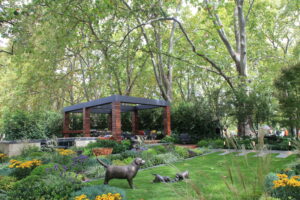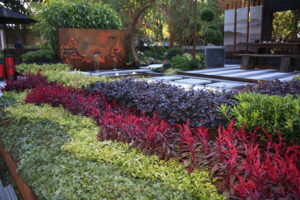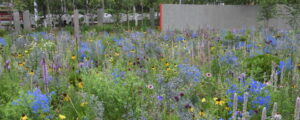
Closer focus on the macro view Part II
By John Fitzsimmons –
Last issue painted the big landscape picture from the 2021 Australian Landscape Conference, leaving several rich understoreys of ideas to be conveyed in this report.
Several topics could be grouped under the subject of ‘plant selection’ and issues like using the words ‘management’ or ‘care’ in design submissions, instead of ‘maintenance’ with its connotations of a cost to be minimised rather than an investment in the ultimate health, value, benefit, utility, longevity and success of the gardens designed and implemented.
The answer to arguments around ‘native’ versus ‘exotic’ is not black and white. The historical and scientific facts are that, worldwide, plants have been transplanted from their indigenous settings with and without human assistance.
There is scope for designers and propagators to work closely to broaden the plant palette. Andrew Laidlaw from the Royal Botanic Gardens Melbourne said they collect and maintain local and international genetic material to draw on as climate changes.
Planning and adapting garden designs and plant palettes for the future concerns our whole industry but is a particular issue in public plantings. The designer’s flexibility to deliver innovation and the desired outcomes, while adapting to discordant pressures and future environments, is often challenged.
Some challenges faced by designers emerged from addresses by James Hitchmough, Professor of Horticultural Ecology at the University of Sheffield (UK), and Jon Hazelwood, Principal (Public Realm) of Hassell Studio, Sydney.
Prof. Hitchmough considers why and how plants in public spaces generate emotion, meaning, and a sense of place and pride, while not being a burden on the public purse.
Writer and garden historian, Tim Richardson, questioned the difference between the concepts of gardens and ‘plant communities’ and are the latter really trying to replicate the communities found in nature?
Hitchmough used the example of Australians trying to create ‘simplified copies’ of native grasslands by taking their cue from the native grasslands that might have once existed on the edge of Melbourne.

The idea of taking it to a range of different places however, took it to an endpoint not found anywhere in the natural world, creating ‘entirely cultural confections’. What they tried to do was utilise an understanding of what allows the natural plantings to persist but how do you maintain this over time, he observed.
Hitchmough said we should be aiming for greater plant diversity, especially in urban plantings.
Some of the core demands on vegetation in cities are enriching human experience and wellbeing and supporting as much non-human life as possible (biodiversity) noting that Australia is less than 1% urban (estimate) whereas UK is 6%. Other demands on vegetation include urban heat island mitigation or stormwater management, which have to be resilient and done sustainably.
Prof. Hitchmough says “The 21st century ‘trinity’ for urban landscape vegetation is:
Aesthetics: what does it look like, do for, and mean to people? It has to be valued.
Urban tolerance: How does it deal with hostility, climate change etc?
Function: what does it do in terms of ecosystem services etc? What benefits does it provide not only for people but for other organisms?
The move to see vegetation as communities, rather than collections of individual species, places more emphasis on traits than historical divisions, such as native or non-native.
Recent data suggests we are moving towards the equator (climatically) at 20km per year, Hitchmough reported. “That’s 1000 km by 2070! In this changing environment, how should we meet the goals for 21st century plant use? By maximising diversity (sub-specific variation, species, life forms, spatial mosaics), maximising spatial complexity (layers, grain, distribution pattern), and do this whether using native or non-native species.”
Jon Hazelwood, also described how, as a landscape architect, he has journeyed into the world of nature-inspired planting and had also contemplated why so much of our public planting in Australia is so desperately dull.
He said incorporating (plant) diversity into city-changing projects is hard. The Sydney North West Rail project involved 32,000 trees and 820,000 shrubs, grasses and groundcovers.
“But time and again the planting of these big public projects is compromised.”
He pointed out how numerous landscape design competitions used words like ‘immersion in nature’ and ‘connecting to nature’ and asked what that meant when it comes to implementing projects and what blocks these projects in our Australian streets.
Many public designs use extensive monocultures and that, when one fails, e.g. due to disease, they all fail, or site issues such as soil compaction or species selection can stymie success.
Jon also mentioned that the complexity of our urban environments, the mix of public and private land, multiple agencies and the authorities can all make implementation of design ideas very difficult.
Another topic being raised is that of putting ‘planting first’. ‘Activisation’ and ‘place making’ and ‘pop-ups’ have become buzzwords, and Jon suggested we have lost touch with what should be our primary artistic material which is (now) so often left to the last minute in design – the plants.
He pointed out how, in many spaces, the default is hard surface. We work out where people are going to walk and gather, and only then, is the tree canopy applied and the green stuff added to the edges. Jon has been advocating for a subtle shift – that we assume all those spaces are green to start with, then we add a tree canopy and only after that, do we carve out the places for people to enjoy, travel through, dwell in and have day-to-day activities within that space.
The design must be ‘of itself’ – in context. Is it relevant here in Australia? Unfortunately, a desire to reproduce indigenous ecosystems in the cities has led directly to a frustratingly limited palette of plants that is used in city spaces, Jon observed. “Australia has 25,000 native plant species – that’s 10% of the world’s total; I suspect in Sydney we use 15 of those species on a day-to-day basis! And we all know them. I have been accused of being cruel to Lomandra longifolia but it is so ubiquitous because it’s reliable. I apologise to Lomandra now but it has come to represent many of these issues.”
Jon illustrated the point with a ‘mass native planting area’ schedule for one project. It extended to L. longifolia, 1m x 1m (mature size), 200mm pots at 6 per m² = 100% coverage = quantity 2010. Nothing else!
“But if you look at the bush it’s not singular plants planted in mulch, it’s layers!”
Which brought his address to “diversity” and another example from a project spec. which demanded “Planting is to be planted in either single species mass planting arrangements, or structured groupings of plant species that are consistent in height and character”. This, he said, sums up a prevailing approach to public planting – it’s just ‘green stuff’ to furnish a space.
Jon is looking at plantings in three dimensions and trying to get specifications to consider 3-4 species per m².
“It’s going to take something like that to change large scale public projects.”
Jon also referred to preconceptions including the native vs exotic arguments.
“These need to be discussed more, and not in a polarising way. We are only using 1% of our native flora commercially, and that’s at the expense of diversity. We’ve all seen Council policies that state natives must be used in order to reduce maintenance and water usage to ensure their success, which is plainly nonsense in many ways.” A diverse native mix needs just as much love and care as a perennial mix, at least in my experience they require different love and care.”

“Likewise, policies and sustainability policies and their rating tools, such as Greenstar, put ‘exotic garden’ on the same level as ‘weed infestations’ … plainly nonsense.”
“It just isn’t black and white that native is good, exotic is bad.”
We should avoid the ‘value engineering’ of planting, he added.
“The word ‘maintenance’ suggests stasis, keeping something green and clipped. We should be changing the word in specifications to ‘management’ or ‘care’.”
We need hard evidence for a lot of this, Jon said. It has been observed that “to frame green infrastructure with well documented costs and benefits, the conversation has to change. We need part-marketing pitch, we need science, and the next step is the development of an Australian evidence base. Without this evidence, the benefits of green infrastructure are hard to pitch in a world that’s increasingly measured in dollar terms.”
Gardener, communicator and musician, Simon Rickard talked about the smallest elements, the plants, and also raised some of the matters he thought were holding us back (from creating better gardens) in Australian horticulture, and where we might go in the future.
He also agreed there were many things to be admired and learned from English garden culture but Simon suspected Australians had learned many of the wrong lessons from the British.
“We tend to obsess over the specific plants they grow in their garden. We also hanker after the garden genres that are intrinsic to the British garden tradition, herbaceous borders, walled gardens, woodland and bog gardens.
“We should learn that the British are experts at sourcing plants from climates similar to their own, and incorporating those plants into their own unique garden aesthetic.”
Britain’s endemic flora is very impoverished – just over 1000 species of land plants, Simon observed, so we should select good plants from climates similar to our own and use those to create our own unique aesthetic.
He thinks what is holding Australia back is “the false dichotomy between Australian and exotic plants. The decision to grow Australian or exotic plants has ceased to become part of normal horticultural discourse in Australia. Somehow natives vs exotics has become a moral issue here, to a degree not seen anywhere else in the world.”
The anti-exotic sentiment has its heart in the right place, born from a desire to protect Australia’s natural heritage and redress some of the vandalism visited on it since European invasion, Simon commented. However, we need to ask whether planting our 20 m² inner suburban backyard with fence-to-fence grevilleas is really going to make a meaningful difference?
“Important conservation goals can’t be achieved as a result of backyard gardening. Responsibility for managing Australia’s natural heritage shouldn’t fall so heavily on home gardeners.”
Simon says “One of the most pernicious myths that leads to this way of thinking is that if you want to attract native animals to your garden, then you have to plant native plants. There is no evidence for this as animals merely see a source of food or shelter or a nesting site and they avail themselves of it. All garden plants attract native animals regardless of their provenance, so we need a little more nuance in the weed debate as well,” adding “It’s not the provenance of the plants that makes great gardens using Australian plants, it’s the quality of the designs and great plant husbandry.”
If we keep demanding inappropriate plants for our gardens, the horticultural industry will continue to supply them. It’s still possible to buy a birch tree from Finland in Perth, a rhododendron from Bhutan in Adelaide, or a lupin from the Alaskan tundra in Sydney. This becomes a vicious circle of supplying and demanding inappropriate plants doing nothing to advance Australian horticulture.
Simon commented that the ‘landscaping approach’, popularised by the TV house and garden makeover shows means hard landscaping becomes the most important element, and the plants are an afterthought that can be bought in bulk to create instant visual impact.
“This creates demand at wholesale nurseries for certain types of plants that can be produced quickly in bulk, bought cheaply, are quick and easy to install as tubestock, and that looks saleable in a 140mm pot year-round. This mentality comes at the expense of slower growing plants, which are difficult to propagate yet make good garden plants, and plants that have an ‘ugly’ period as part of their life cycle. This approach will naturally exclude hundreds of very worthy garden plants.”
He regards landscaping and garden design as completely different skills with different motivations and aims. Landscaping tends to overlook the fact that gardening is a process not an outcome. It treats gardens as something that can just be rolled out, installed in a day and that’s a job done, walk away. Whereas we know that installing a garden is the beginning not the end of something.
Nearly 20% of the world’s flora originate from Mediterranean zones, giving much of southern Australia a huge palette of plants to work with. In our climate, we can grow a fifth of all the world’s plants, he said.
“Summer is the dormant season in Mediterranean climates. We can show Australian gardeners that dormancy can be beautiful: shapes, textures, rhythm and compositional concepts become more important in a summer dormancy garden than simply colour, which is what we have been conditioned to value.”
“It’s our job to give our clients the gardens they need not the gardens they want.”
